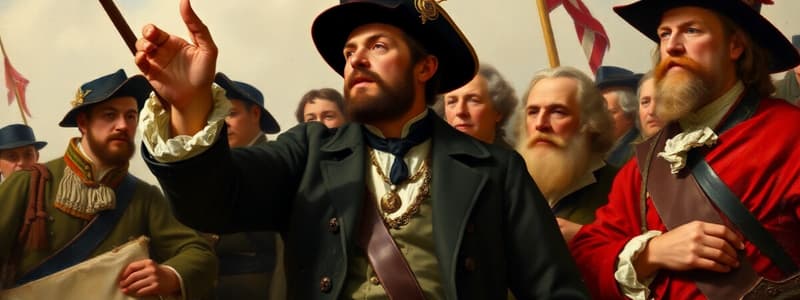Podcast
Questions and Answers
What was one of Martin Luther King's significant contributions to the Civil Rights movement?
What was one of Martin Luther King's significant contributions to the Civil Rights movement?
- He organized peaceful demonstrations for economic justice. (correct)
- He opposed the Poor People’s March.
- He advocated for segregated schools.
- He promoted violent actions against segregationists.
What event marked the assassination of Martin Luther King Jr.?
What event marked the assassination of Martin Luther King Jr.?
- At his childhood home in Clinton.
- While helping striking sanitation workers in Memphis. (correct)
- At a civil rights demonstration in Washington.
- During the Poor People’s March.
How did the speaker’s experiences during segregation influence their actions later in life?
How did the speaker’s experiences during segregation influence their actions later in life?
- They ignored racial injustices altogether.
- They decided to avoid public life.
- They became involved in the integration movements. (correct)
- They actively campaigned for segregationist views.
What emotion did the speaker experience when facing racial prejudice in the information technology industry?
What emotion did the speaker experience when facing racial prejudice in the information technology industry?
Which biblical figure is mentioned as exemplifying the resolution to persist in one's beliefs?
Which biblical figure is mentioned as exemplifying the resolution to persist in one's beliefs?
Why did the speaker and their peers integrate the public swimming pool in Clinton?
Why did the speaker and their peers integrate the public swimming pool in Clinton?
What was the condition of Lincoln School compared to the white school?
What was the condition of Lincoln School compared to the white school?
What did the signing of the Declaration of Independence symbolize for the signers?
What did the signing of the Declaration of Independence symbolize for the signers?
Which statement best describes Harriet Tubman's leadership style?
Which statement best describes Harriet Tubman's leadership style?
What was the primary military disadvantage faced by the colonies during the American Revolution?
What was the primary military disadvantage faced by the colonies during the American Revolution?
What did Benjamin Franklin imply with his statement about hanging together?
What did Benjamin Franklin imply with his statement about hanging together?
What was one significant aspect of the British military presence during the American Revolution?
What was one significant aspect of the British military presence during the American Revolution?
How did Stephen Hopkins' condition affect his signing of the Declaration?
How did Stephen Hopkins' condition affect his signing of the Declaration?
What role did Martin Luther King, Jr. play during the Civil Rights Movement?
What role did Martin Luther King, Jr. play during the Civil Rights Movement?
What does the phrase 'Live North or die here' signify about Harriet Tubman's mission?
What does the phrase 'Live North or die here' signify about Harriet Tubman's mission?
Flashcards
Revolutionary War patriots
Revolutionary War patriots
Colonists who risked their lives signing the Declaration of Independence, knowing the threat of British execution.
Declaration of Independence
Declaration of Independence
A document declaring American independence from British rule, signed in 1776.
American colonists' military disadvantage
American colonists' military disadvantage
The colonists had a significantly smaller, less equipped army compared to the well-trained and large British and Hessian forces.
Harriet Tubman
Harriet Tubman
Signup and view all the flashcards
Underground Railroad
Underground Railroad
Signup and view all the flashcards
Martin Luther King, Jr.
Martin Luther King, Jr.
Signup and view all the flashcards
Civil Rights Movement
Civil Rights Movement
Signup and view all the flashcards
Taking a Stand
Taking a Stand
Signup and view all the flashcards
Martin Luther King Jr.'s activism
Martin Luther King Jr.'s activism
Signup and view all the flashcards
Civil Rights Movement goals
Civil Rights Movement goals
Signup and view all the flashcards
King's assassination
King's assassination
Signup and view all the flashcards
Segregation in the US
Segregation in the US
Signup and view all the flashcards
Integration challenges
Integration challenges
Signup and view all the flashcards
Persistence in beliefs
Persistence in beliefs
Signup and view all the flashcards
Personal conviction
Personal conviction
Signup and view all the flashcards
Study Notes
Taking a Stand: Historical and Personal Examples
-
Historical Figures: The text highlights figures like Benjamin Franklin, Stephen Hopkins, John Hancock, Harriet Tubman, and Martin Luther King, Jr., who exemplified courage in taking a stand.
-
Declaration of Independence: Signing the Declaration of Independence in 1776 was a high-risk act of treason against the British, potentially resulting in death. Franklin warned of the need for unity. Hopkins demonstrated courage despite palsy, and Hancock made his signature large for the King's visibility, demonstrating courage in the face of immense odds.
-
American Revolution: The colonists faced insurmountable military odds (9,000 poorly-equipped troops, compared to 32,000 fully-equipped professional British and German soldiers, and 130 warships). The colonists stood for their freedom nonetheless.
-
Harriet Tubman: Led an estimated 300 enslaved African-Americans to freedom via the Underground Railroad, facing death for those who were caught.
-
Martin Luther King, Jr.: Led the Civil Rights Movement, facing violence (including bombings of his home), beatings, and arrests because of his nonviolent political action. He believed in economic justice and sought to end the Vietnam War, and was assassinated in 1968.
-
Civil Rights Movement: The movement aimed to end racial injustices in America. Key figures like King paved the way for others to follow.
-
Personal Account: The author recalls their personal experiences with the repercussions of segregation, including attending an all-black school, integrating the public swimming pool, and experiencing subtle resistance later on even in the face of achieving notable success in their career.
-
Segregation and Integration: The author experienced segregation's profound impact in their youth. Their integration of the public school and swimming pool were pivotal life experiences demonstrating their willingness to oppose injustice and serve as a role model.
-
Modern Resistance to Progress: Even seemingly overcoming huge inequalities, subtle pockets of resistance remain, such as being judged because of race or gender.
-
Jesus's Example: The author references Jesus's teachings (John 15:18-19) to exemplify the necessity and determination to consistently stand up for one's convictions.
Core Themes
-
Courage: The text emphasizes the courage required by those who take a stand against adversity.
-
Values: The author and the historical figures cited demonstrate the value of standing up for one's beliefs, even in the face of opposition.
-
Social Justice: Taking a stand is vital in achieving social justice and equality, which is a recurring theme.
-
Persistence: The desire and willingness to persevere despite numerous difficulties and obstacles are key.
Studying That Suits You
Use AI to generate personalized quizzes and flashcards to suit your learning preferences.




